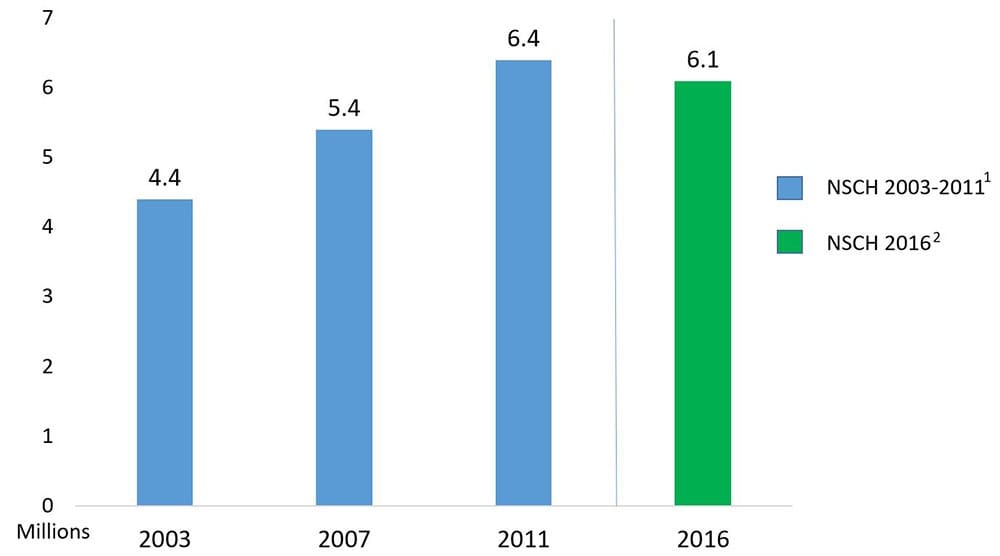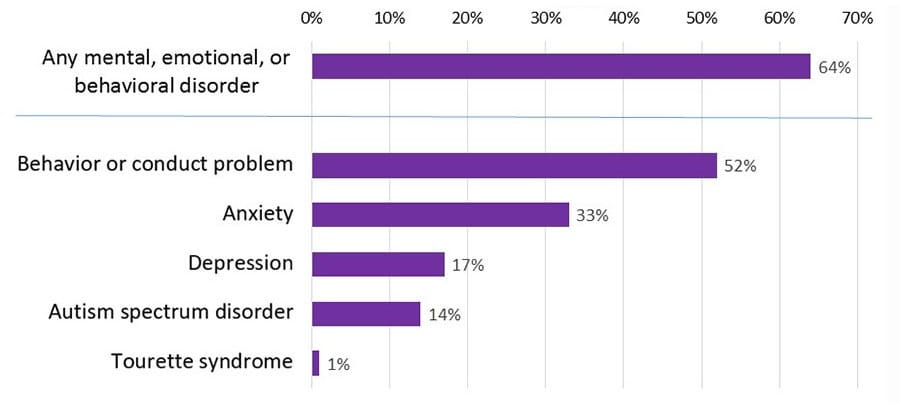The CDC analyzes datasets from parent surveys and healthcare claims to examine patterns in the diagnosis and treatment of attention-deficit/hyperactivity disorder (ADHD).
Estimates for ADHD diagnosis and treatment may differ based on the data source.
This page provides ADHD data from multiple sources.
Facts about ADHD
Millions of children in the United States have received an ADHD diagnosis.
Based on a national parent survey conducted in 2016, an estimated 6.1 million children (9.4%) have been diagnosed with ADHD at some point.
This figure includes:
-
- 388,000 children aged 2–5 years
- 2.4 million children between the ages of 6 and 11 years old.
- 3.3 million children between the ages of 12 and 17 years.
- Boys are diagnosed with ADHD more often than girls, with rates of 12.9% compared to 5.6%.
The prevalence of ADHD diagnoses among children in the U.S. has varied over time, as the below graph shows.
The below graph shows the estimated number of children in the U.S. who have ever been diagnosed with ADHD:

This compares this study with this study. The first study looked at telephone survey data, and the estimate includes children 4-17 years of age.
The second study estimate includes children 2-17 years of age.
Due to differences in methodology, estimates from the 2016 NSCH survey cannot be directly compared with those from previous NSCH data.
Additionally, to better address ADHD in younger children, the age range was expanded to include children aged 2-17 years.
Many children with ADHD often have additional disorders.
According to a national parent survey conducted in 2016, 6 out of 10 children with ADHD also had at least one additional mental, emotional, or behavioral disorder:
- Approximately half of children with ADHD also experienced a behavioral or conduct disorder.
- Approximately 30% of children with ADHD experience anxiety.
Other conditions that can affect children with ADHD include depression, autism spectrum disorder, and Tourette syndrome.

ADHD Treatment
ADHD treatment may involve behavior therapy, medication, or a combination of both.
According to the American Academy of Pediatrics (AAP), children aged 6 and older should ideally receive both behavior therapy and medication.
For children younger than 6, behavior therapy is the preferred first-line approach.
Approximately 75% of children in the U.S. who currently have ADHD receive treatment.
A 2016 national parent survey provided insights on medication and behavioral treatments for children aged 2–17 years who had a current ADHD diagnosis.
1. 62% were taking ADHD medication
- Ages 2–5: 18%
- Ages 6–11: 69%
- Ages 12–17: 62%
2. 47% received behavioral treatment
- Ages 2–5: 60%
- Ages 6–11: 51%
- Ages 12–17: 42%
3. A total of 77% were undergoing treatment. Among these children:
- About 30% were treated with medication alone.
- About 15% received behavioral treatment alone.
- About 32% children with ADHD received both medication treatment and behavioral treatment.
4. Approximately 23% of children with ADHD were not receiving either medication or behavioral treatment.
It is unclear what kind of behavioral treatment these children underwent.
The majority of children with ADHD receive certain types of support or services.
A more comprehensive national survey conducted in 2014 gathered detailed information about the treatments and services that children with ADHD had received at any time before the survey took place.
This study involved interviews with parents of children aged 4 to 17 years who had been diagnosed with ADHD at some point in their lives.
- Nearly 90% of children received school support, which includes classroom assistance and accommodations.
- Approximately 60% of children had undergone some form of behavioral therapy or skills development training.
- Three out of ten children received behavior therapy delivered by their parents.
- Four out of ten individuals received training in social skills.
- Three out of ten received peer interventions.
- Two out of ten received cognitive behavioral therapy.
Healthcare claims data reveal gaps in treatment.
In addition to data reported by parents, healthcare claims from Medicaid or employer-sponsored insurance offer another means of examining treatment patterns.
A study analyzing healthcare claims data for young children in the U.S. found:
- Between 2008 and 2011, children aged 2 to 5 years enrolled in Medicaid were twice as likely to receive clinical care for ADHD compared to their peers of the same age covered by commercial employer-sponsored insurance.
- Approximately 75% of children aged 2–5 years who received clinical care for ADHD, as documented in their healthcare claims from 2008 to 2014, were prescribed ADHD medication, while fewer than half received any psychological services.
It is unclear what types of psychological services these children received or if they underwent behavioral treatments that were not recorded in the healthcare claims data.

